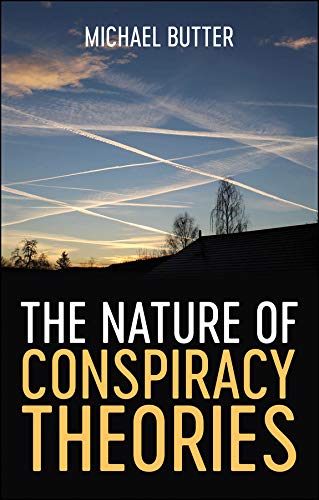
by Katherine Preston

Published by Polity Press, 2020 | 202 pages
With the emergence and spread of Covid-19 in early 2020, a surge on the U.S. Capitol Building, and the election of a new president, this last year has seen its share of conspiracy theories. These events and others make Michael Butter’s The Nature of Conspiracy Theories (2020) especially timely and relevant. In this comprehensive examination of conspiracy theories, Butter not only defines what constitutes conspiracy theories, but delves into why conspiracy theories exists, how they spread, and the effects they have on modern culture. Butter’s main argument, which shapes the entire study, is not that conspiracy theories are new or have even changed much in their nature, but that the very status—the power and influence—of conspiracy theories is what has changed over time.
From the outset, Butter illustrates that main argument—that conspiracy theories are nothing new—by opening the book’s formal introduction with a 1920 speech by Winston Churchill that either overtly or subtly suggests a number of conspiracy theories. In the speech, Churchill references several anti-Semitic stereotypes, claiming that there are three types of Jews: two that are helpful and a third that is destructive to humanity. He further argues that Jews had long wanted to establish a global Communist state, claiming further that this truth is older than communism itself. Churchill’s speech is a prime example of the kinds of conspiracies that continue to this day: “The suspicions regarding Jews, Freemasons and the Illuminati perpetuated in Churchill’s speech remain all-pervasive,” Butter writes.
The introduction sets the tone for the rest of the study, in which Butter offers numerous examples of conspiracies while theorizing various classifications and heuristics we might apply to them, including typologies and directional considerations; that is, where these theories originate and how they travel. In chapter one, he attempts to define conspiracy theories and some of their permutations. Important concepts he outlines include the notion of top-down, bottom-up, internal, and external varieties of conspiracy theories. He also distinguishes conspiracy theories from actual conspiracies, such as Big Oil’s decades long effort to discredit the evidence of climate change. The determination of top-down versus bottom-up conspiracies depends on the position of the conspirators; that is, whether the conspirators have dominant power (top-down) or are trying to subvert power (from the bottom up). This designation is often contingent upon political and cultural happenings, including war, elections, or revolution.
The top-down and bottom-up distinction also depends on whether conspirators are internally or externally positioned in relation to an organization or party. In other words, are they outside and trying to infiltrate the organization they hope to take down, or are they already a member and bent on their own agendas? Butter claims that these factors will shape the nature of the theory, its power to persuade, and how quickly and widely it spreads. He also posits the notion of event conspiracy theories, which are exactly as they sound: theories surrounding a particular event such as the Kennedy assassination or 9/11. Finally, the difference between real conspiracies and conspiracy theories depends on size. True conspiracies, Butter claims, generally involve a small group of people, whereas conspiracy theories usually depict a scenario in which a large number of people are involved, such as the theory around the moon landing. That so many people would be involved in a conspiracy like that is highly unlikely.
The chapters that follow build on these initial definitions and designations to show how conspiracy theories operate, their various modes, and their effects. Perhaps one of the more interesting chapters—at least from a rhetorical standpoint—is chapter two, in which Butter explores exactly how conspirators argue and try to convince people. He describes how conspirators often construct their arguments backward, starting with who most benefits from the conspiracy to identify those most likely responsible. This in itself is a logical fallacy, because even if a party benefits from an event (Butter cites the Bush administration and 9/11 as a case in point), it doesn’t necessarily mean they caused it.
In order to gain credibility, conspiracy theorists unsurprisingly borrow their style from academics, often using similar citation styles and trying to point to sources they deem credible. Butter refers to Robert Welch’s The Politician, in which the actual text consists of 300 pages, but the bibliographic content spans an astonishing 200 more pages. The problem is that the sources the authors cite are often the actual sources of the theory or of other similar conspiracy theories, essentially creating a circular argument. Still, the role of academics in conspiracy theories is complicated. On the one hand, conspiracy theorists love when they can cite an academic or expert who backs up their theories, but they also are wary of academics or experts because many of them can and do just the opposite: prove their theories to be unfounded.
Butter’s exploration of the argumentative methods and evidence is also notable and fascinating. Conspirators often use arguments from analogy or metaphor to gain influence. An argument from analogy consists of drawing comparisons to another act that is somehow supposed to prove a subsequent act: the 9/11 conspiracy about Bush’s involvement is true because he lied about the events preceding the Iraq invasion of 2003. Conspiracy theories are often laden with entirely negative, apocalyptic, and metaphorically charged language as well. This may consist of describing individuals as the Devil, serpents, or demons from hell, for example. These are powerful rhetorical tropes, since the actual evidence they have – documented, scientific, or otherwise – is often thin or unreliable. Theorists often use leaked documents that, once made public, are meant to speak for themselves and not be questioned or contextualized by readers. Conspiracy theorists often use film as a medium to spread their theories given its visual and auditory potential, which in turn can have powerful emotional effect.
The final chapters of The Nature of Conspiracy Theories examine why people believe in conspiracy theories, the historical evolution of them, and the effects of the internet on the state of conspiracy theories today. In examining why people believe in conspiracy theories, Butter offers both a psychological, emotional, and evolutionary explanation. While conspiracy theory believers have been stigmatized as mentally ill for believing in sometimes controversial and farfetched ideas, a lot more followers exist than could likely be so diagnosed in a clinical setting. So what is the explanation for the widespread adoption and spread of some conspiracy theories? Butter explains that, much like religion or even the extreme version found in cults, “conspiracy theories create meaning, reduce complexity and uncertainty, and emphasize human agency; they allow the conspiracy theorist to feel a sense of superiority over the unsuspecting masses.” Those who subscribe to conspiracy theories, in turn, get something to believe in that gives order to an otherwise scary and chaotic world. In that sense, they offer a more appealing alternative to the world of chaos and coincidence of our modern scientific worldview. It’s no wonder, then, that conspiracy theories thrive in times of political unrest, economic despair, or disasters (natural or manmade). The internet has been integral in the spreading and adopting of these ideas, as it forms a community that in itself lends a sense of credibility—power in numbers.
Butter’s comprehensive study effectively covers myriad sources, causes, and characteristics of conspiracy theories, and offers deep, close readings of some theories, documents, speeches, and other conspirator modes. This is a timely and important study, especially given the extent and power of the internet to empower individuals, disseminate information, and collect followers. Butter offers a complex and illuminating look at the psychology behind conspiracy theories themselves and the people who believe in them. The last few years, specifically the Trump presidency and the questions around the legitimacy of the election, show just how relevant and crucial such a study is.
Deborah Harris is Associate Director and Continuing Lecturer in the Writing Program at University of California, Santa Barbara. She is the author of Media and the Rhetoric of Body Perfection (Routledge, 2014), as well as more recent journal articles on composition pedagogy, trauma, and writing for health professionals. Her research includes medical rhetoric, materialist rhetoric, popular culture, and composition pedagogy.















click to see who
MAKE Magazine Publisher MAKE Literary Productions  Managing Editor Chamandeep Bains  Assistant Managing Editor and Web Editor Kenneth Guay  Fiction Editor Kamilah Foreman  Nonfiction Editor Jessica Anne  Poetry Editor Joel Craig  Intercambio Poetry Editor Daniel Borzutzky  Intercambio Prose Editor Brenda Lozano  Latin American Art Portfolio Editor Alejandro Almanza Pereda  Reviews Editor Mark Molloy  Portfolio Art Editor Sarah Kramer  Creative Director Joshua Hauth, Hauthwares  Webmaster Johnathan Crawford  Proofreader/Copy Editor Sarah Kramer  Associate Fiction Editors LC Fiore, Jim Kourlas, Kerstin Schaars  Contributing Editors Kyle Beachy, Steffi Drewes, Katie Geha, Kathleen Rooney   Social Media Coordinator Jennifer De Poorter
MAKE Literary Productions, NFP Co-directors, Sarah Dodson and Joel Craig Â